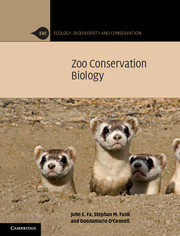Book contents
- Frontmatter
- Contents
- Foreword
- Preface
- Acknowledgements
- 1 Biodiversity and zoo conservation biology
- 2 Protecting species and habitats
- 3 Zoos in focus – public exhibition or conservation
- 4 Keeping animals in captivity
- 5 Viable captive populations – the numbers game
- 6 Captive breeding and zoos
- 7 Returning animals to the wild
- 8 Educating the public
- 9 Turning zoos into conservation centres
- Appendix 1 Commonly used abbreviations
- Appendix 2 Scientific names of species mentioned in the text
- Appendix 3 Inbreeding
- Appendix 4 Population sizes – definitions and implications
- Appendix 5 Captive breeding and genetics – definitions
- References
- Index
- Plate section
1 - Biodiversity and zoo conservation biology
Published online by Cambridge University Press: 05 August 2012
- Frontmatter
- Contents
- Foreword
- Preface
- Acknowledgements
- 1 Biodiversity and zoo conservation biology
- 2 Protecting species and habitats
- 3 Zoos in focus – public exhibition or conservation
- 4 Keeping animals in captivity
- 5 Viable captive populations – the numbers game
- 6 Captive breeding and zoos
- 7 Returning animals to the wild
- 8 Educating the public
- 9 Turning zoos into conservation centres
- Appendix 1 Commonly used abbreviations
- Appendix 2 Scientific names of species mentioned in the text
- Appendix 3 Inbreeding
- Appendix 4 Population sizes – definitions and implications
- Appendix 5 Captive breeding and genetics – definitions
- References
- Index
- Plate section
Summary
‘It may well be true that Sumatran tigers and Hyacinthine macaws seem to contribute very little to our daily lives. There is, though, a strong group of arguments…which say that wild animals and plants can be good for us and this is a good reason to hang on to them’
(Colin Tudge)Introduction
In practical terms, species conservation initiatives must be directed at protecting the largest number of forms as cheaply as possible. Economy, not just in monetary terms but also in achieving parsimonious ways of protecting species, is important, since resources are often limited. Debates rage over whether one or another approach is more appropriate, often with much time and effort expended and little results in hand. Biodiversity conservation has to proceed along various fronts achieved by the integration of methods to halt the current extinction of species. This book attempts to undertake this task for conservation biologists working in zoos. Zoos argue that their role is increasingly concerned with the preservation of species yet the information required for zoo staff to make informed decisions on any aspect of captive animal care, population management, etc., is not readily accessible.
- Type
- Chapter
- Information
- Zoo Conservation Biology , pp. 1 - 28Publisher: Cambridge University PressPrint publication year: 2011



